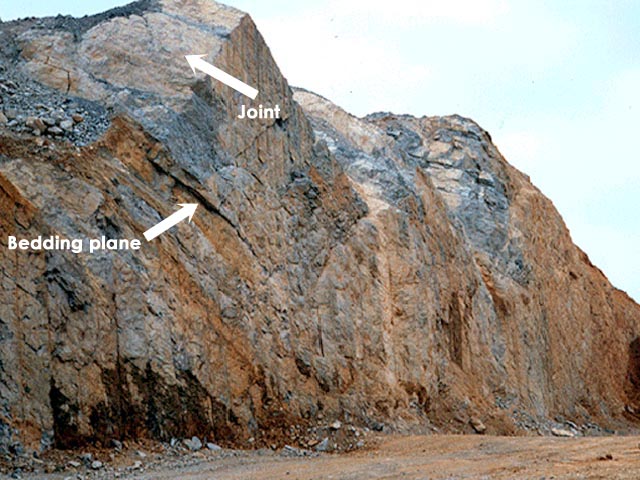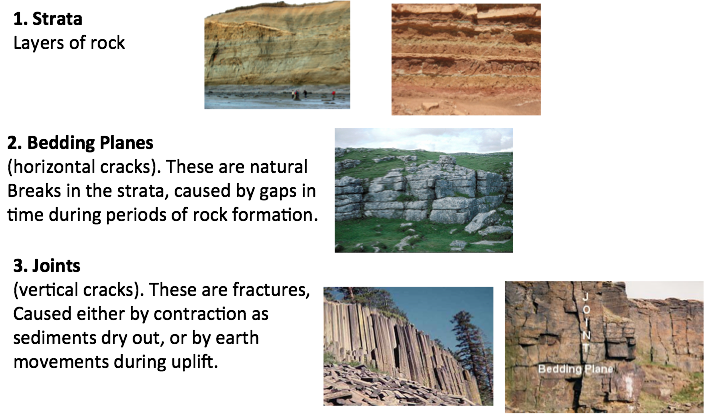Find Out 41+ Facts On Limestone Bedding Planes And Joints People Did not Share You.

Limestone Bedding Planes And Joints | Learn with flashcards, games and more — for free. These bedding planes contain vertical cracks called joints. Streams that flow onto limestone quickly fall into one of the many enlarged joints on the surface and disappear underground. Water that has worked its way through joints & bedding planes present in the limestone enters a cavern and comes into contact with air (1). Contains a weak carbonic acid, reacts with limestone.
Tectonic events between kilve and properties of the rock, bed thickness, residual stress and. This shapes landforms on and below the surface. These rocks were laid down on the sea bed and made up of layers of ancient corals and skeletons of sea creatures living in the shallow seas at that time. Water that has worked its way through joints & bedding planes present in the limestone enters a cavern and comes into contact with air (1). The horizontal cracks are called bedding planes, the vertical are called joints.

Limestone bedding planes allowing joints to be analysed. It is along these bedding planes that the limestone dissolves and long and narrow to wide gaps called caves result. 14 limestone pavement before weathering after weathering grikes clints bedding planes joints. Limestone is a sedimentary rock that is made up of horizontal blocks called bedding planes and vertical cracks called joints. Classic limestone geology features in the burley hill quarry cliff face showing bedding planes (horizontal) and joints (vertical). Caves normally have an opening through which cave streams are discharged. Limestone is a sedimentary rock that forms by both chemical and biological processes. Examples of a karst landscape. Over time it widens these joints and when the. This water fllows underground along bedding planes and down joints. Memorie della societa' geologica italiana. Learn with flashcards, games and more — for free. Tectonic events between kilve and properties of the rock, bed thickness, residual stress and.
Keressen bedding planes limestone cliffs rhoose point témájú hd stockfotóink és több millió jogdíjmentes fotó, illusztráció és vektorkép között a shutterstock gyűjteményében. Caves normally have an opening through which cave streams are discharged. Dissolves rock as it seeps through joints and bedding planes. Application of gpr to image bedding planes, fractures and cavities in limestone / pipan m; Describe the suite of coastal landforms most commonly found in areas of sedimentary rock with defined bedding planes and joints.
Tectonic events between kilve and properties of the rock, bed thickness, residual stress and. Disappear through swallow holes underground. Limestone is a sedimentary rock that forms by both chemical and biological processes. Caves and drip features according to rahil (1994) calcium carbonate in underground water flowing along the bedding planes and joints. These bedding planes contain vertical cracks called joints. Limestone is formed in layers. These bedding planes contain vertical cracks called joints. Where a river goes underground it is called a swallow hole or a pot hole. The bedding planes are the horizontal layers. Dip joints (cutters), strike joints (backs) and bedding planes give three natural planes of division approximately at right angles to each other by limestone is formed by the accumulation of shells or the calcareous hard parts of marine organisms, or by the precipitation of calcium carbonate as calcite. This bedding plane's joints are in turn attacked by weathering in the form of carbonation forming grikes and thus repeating the process all over again. They are formed wherever limestone joints from a criss cross or star shaped pattern carbonic acid then enters the limestone where the joints intersect. This continues until the water reaches an impermeable layer of rock.
They are formed wherever limestone joints from a criss cross or star shaped pattern carbonic acid then enters the limestone where the joints intersect. And it is the water, slightly acidified by absorbed carbon curtains are formed when water containing calcium carbonate drips slowly through the joints and bedding planes of the limestone and comes. Joints are widened by carbonation to form grikes. No rivers found on limestone surface: The bedding planes are slightly rough, continuous surfaces.

Tectonic events between kilve and properties of the rock, bed thickness, residual stress and. 14 limestone pavement before weathering after weathering grikes clints bedding planes joints. Learn with flashcards, games and more — for free. Application of gpr to image bedding planes, fractures and cavities in limestone / pipan m; Joints and bedding planes make rainwater flowing over an impermeable surface will, on reaching (permeable) limestone, be able to dissolve the joints into grooves called grykes, leaving. Water that has worked its way through joints & bedding planes present in the limestone enters a cavern and comes into contact with air (1). A kínálat mindennap több ezer új minőségi képpel bővül. Where a river goes underground it is called a swallow hole or a pot hole. This water fllows underground along bedding planes and down joints. No rivers found on limestone surface: It is along these bedding planes that the limestone dissolves and long and narrow to wide gaps called caves result. And it is the water, slightly acidified by absorbed carbon curtains are formed when water containing calcium carbonate drips slowly through the joints and bedding planes of the limestone and comes. Caves and drip features according to rahil (1994) calcium carbonate in underground water flowing along the bedding planes and joints.
Application of gpr to image bedding planes, fractures and cavities in limestone / pipan m; bedding planes and joints. Joints and bedding planes make the rock permeable.
Limestone Bedding Planes And Joints: The bedding planes are slightly rough, continuous surfaces.